|
Steering racks. Comical, flightless, web footed little barstards.
No wait. That's penguins. Steering racks. Started off as a
nice straight forward job. The rack had always had play since I bought the
car. At first I thought it was just the way it was as it was an old car,
but after helping Steve Payne fit a new one to his car, I found out they
were meant to be play free. Various MOT testers had mentioned
that there was play. Not enough to fail the car, but they mentioned it.
There was also about 1 inch of free play at the dead ahead position.
Again, not enough to be a problem on most roads, but on the narrow country
lanes where I live it was enough so you lost a bit of confidence at
placing the car where you wanted it on the road. There was always
something more important to do on the car previously, but as I had
completed all the other jobs on my list, it was time to sort it out. Chris
Miller had a refurbished rack knocking about, so he let me have that one
so I didn't have to send mine away. A word to the wise!
Jensen, Jaguar, and Aston Martin all used this rack. Jensen and Aston had
different valve settings which made the steering a little heavier and more
"feel-some". Jaguar used very light valve setting, which gave feather
light steering, with less "feel"
One rack refurbishment company sent Steve Payne a Jaguar spec
rack by mistake, and Steve said it was like steering on ice. Make sure you
specify the right rack if you use a non Jensen supplier. A
second word to the wise!
For some reason some of the refurbished racks won't fit the hole
spacing on the Jensen chassis. Whether the Jag or Aston versions has very
slightly different hole spacing's, or whether when the racks are stripped
and rebuilt they are reassembled a thread longer or shorter I don't know,
but about 1 in 3 will not fit. This means having to open up the holes in
chassis to suit so check your old rack against the new to see if the holes
match.
Bizarrely, some times only 1 hole will be out... Here is an
overview of the rack, U/J/s, and doughnut:
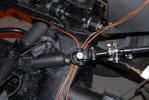 First
job is to split the track rod ends. A proper splitter will prevent damage
to the track rod, and make life a lot easier.
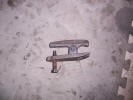 I bought a complete set of track rod and ball joint rubbers off
E-Bay for £10. Search for "Jaguar Rod Boots". They come as a set of 8, so
you can change all your rubber boots in one go if they are damaged. The
annoying thing is they don't come with the spring locking rings (daft if
you ask me), so I bought some stainless steel locking wire to do the job.
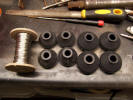 Next job is to undo the 4
bolts that hold the rack to the chassis. These are difficult to get at,
and the only thing I could find to do it was a long swan neck ring
spanner. 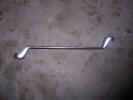
The last
item holding it in are the flexible hydraulic pipes. Again difficult to
get at as they are obscured by metal pipes on to of the rack.
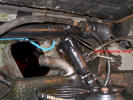 The picture
above is from when we did Steve Payne's car, and we removed the radiator
thinking it would be in the way. As we have since found out, removing the
fan shroud will give enough room, and save the mess of draining the
radiator
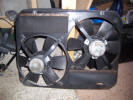 You can now
slide the rack over to the passenger side, and get it under the passenger
wheel arch. Move it over far enough to allow the drivers side track rod
end to be lifted up in the engine bay.
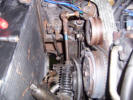 Once the drivers
side is clear in the engine bay, start and feed it in from the passenger
side, and lift it out of the engine bay. It will be easier with 2 people,
but I did this on my own.
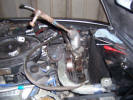 New rack waiting
to go in. If you are reusing the old pipes, or fitting new ones, do it now
rather than try when it is back in the car...
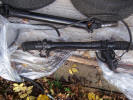 Refitting is the
reverse of the above, but take care to make sure you really tighten the 4
bolts that hold the rack in as the rack take a lot a pressure steering
such a heavy car. If your really bothered, so can fit a pressure
gauge either permanently or temporarily to check you steering pump
pressures. The pressure developed by the pump is dependant on the
model and the year, and can vary from 1050 to 1550psi. It would be advisable to check in the
workshop manual for your model of car.
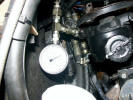 While I was taking it out I thought it a good time to overhaul the
steering column at the same time. The column comes in 3 sections; there is
one in the car, where there are really no user serviceable parts, and the
2 sections in the engine bay from the bulkhead to the rack.
The sections in the engine bay comprise 2 shafts with a universal
joint (U/J) at the end, and a rubber "doughnut" which joins the 2 shafts
together.
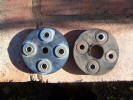 Old and new doughnuts. The new
one needs to have the hole in the middle enlarged, and the metal "rivets"
crimped in the vice as they are loose and spin around when supplied new. Old and new doughnuts. The new
one needs to have the hole in the middle enlarged, and the metal "rivets"
crimped in the vice as they are loose and spin around when supplied new.
The plan was to refurbish the 2 U/J's, and replace the rubber doughnut.
This is where it all started to go horribly wrong... I undid
the rubber doughnut (4 bolts) and removed the 2 bolts that hold a support
arm. The 2 U/J's could now be removed from the steering
rack and the steering column. The U/J on the rack
came off easily enough (just 1 bolt secures it), but when I tried to
remove the U/J from the steering column, instead of the U/J
coming off, the whole of the column from inside the car came out
instead!
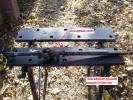
This meant a new internal column was required. Luckily we had one in our
stock of spares, so a trip to Steve Payne's had one sorted. The
next step was to refurbish the U/J's. I spoke to Andy Brookes of
Appleyard's spares and he has new complete U/J's, and refurbishment kits
available. When I asked which was best Andy told me the complete new ones
are not as substantial as the originals, so I decided on the refurbishment
kits. I started by removing the circlip's
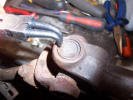 then pressing out the old
U/J bearings in the vice using sockets.
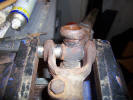 Push it out as far as you can
using a socket a bit smaller than the bearing Push it out as far as you can
using a socket a bit smaller than the bearing The finish it off
by using a socket larger than the bearing, so it can push inside.
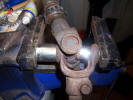 You can only press them out
so far, then you have to use some grips to finish pulling the bearings
out.
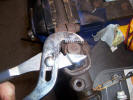
This is what the inside of the bearing looks like (there are 4 per U/J)
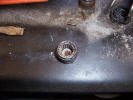 The inside of a needle roller
bearing The inside of a needle roller
bearing
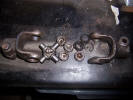 Completely disassembled.
Completely disassembled. It turns out that the top U/J very
rarely wears out as it is mounted in a straight line, but the bottom one
onto the rack wears out quite badly as it is always turning at an angle.
This was the case with mine where some very noticeable "flat spots" could
be felt in the joint when I moved it around. The steering on my car would
sometimes "stick" in some positions, so I think this may be the cause.
Although the top U/J doesn't wear, it does get very hot from the
exhaust manifold, and was very hard to get off the shaft due to the heat
corroding it on. I had to use a lot of penetrating oil and a large "fine
adjustment" tool.
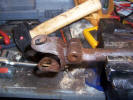
Once they were disassembled, it was a case of cleaning the rust out of the
holes with a round file, and clearing out the circlip holes with a small
screwdriver.
It was then ready for the new kit to be fitted.
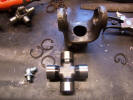 I fitted a new circlip to
one side so I knew how far to press the bearing in.
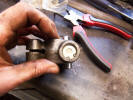 The refitting is the
reverse, but taking great care to keep dirt out of the new bearings, and
to press them in square.
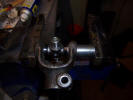
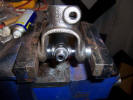
Make sure the grease nipple is fully screwed in so it doesn't catch
on the joint, and that it is angled so you can get a grease gun on to it.
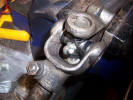
The next job is to remove the column section from inside the car.
This is held in by 3 bolts near the ignition switch, and 3 bolts where it
goes through the bulkhead.
 Under the wheel arch where the column passes through the bulkhead.
Under the wheel arch where the column passes through the bulkhead.
Close up of the bearing on the end of the column. This one has
collapsed, and you can see the ball bearings at the bottom.
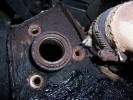 Note how close it is to the
exhaust manifold. Note how close it is to the
exhaust manifold. Once these 3 bolts were out, it was time to
move into the car. You will need to remove the steering wheel, and some of
the dash trim. The get the trim from around the indicator stalk
you will need to remove the finishers from the bottom of the dash
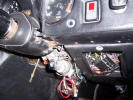
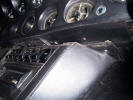 This will allow you to
access the screws which retain it.
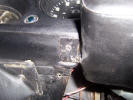
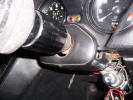 You can them remove the
jubilee clip which holds the ignition switch in place.
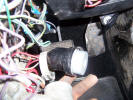 And then remove the bulb
holder from the ignition switch illumination light, and the wire from the
indicators to the column.
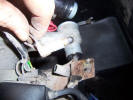
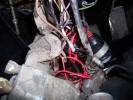 Once these are removed, undo
the steering column reach adjuster, and remove it and the coil spring
behind it.
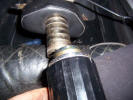
You can now undo the screws which hold the indicator mechanism in place
and remove the indicators
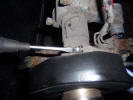
The 3 bolts which hold the column in place can now be removed.
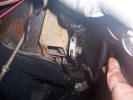 The column was then removed
to reveal the collapsed bearing
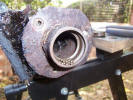 A close up of the collapsed
bearing at the end of the column. A close up of the collapsed
bearing at the end of the column.
The spare steering column had a better bearing at the end in that it
hadn't collapsed, but you could hear it was bone dry, and there was no
real way of getting any grease into to it. What appears to be a large
castellated metal nut holding the bearing in turns out to be plastic, and
attempts to move it to get some grease into the bearing were abandoned as
it was obvious it would break very easily.
I called Andy Brookes who informed me the plastic castellated nut and
the bearing were no longer available, but that he had got some phosphor
bronze bushes made to replace the bearing, and that they wouldn't require
greasing and would stand up to the heat from the exhausts.
As I didn't want to be doing this all again when the replacement
bearing finally failed at some time, I ordered the phosphor bronze bush
from Andy.
A couple of days later this little beauty arrived.
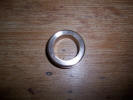
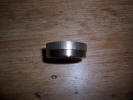 This should stand the heat
without the need for grease. This should stand the heat
without the need for grease.
I couldn't understand why my column had come apart, but looking at the
replacement, the internal column is in 2 pieces, in which one is a slide
fit inside the other. They are then held together by plastic pegs.
The idea of this is that the external column is made up of a "lattice",
which collapses in a front impact rather than driving the column up into
the driver.
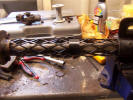 If you look
through the lattice you can see one of the round plastic pegs. If you look
through the lattice you can see one of the round plastic pegs.
During the lattice collapsing, the plastic pegs snap, and allow the 2
halves of the internal column to slide over each other, again stopping the
column being driven into the car
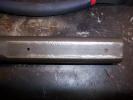 The remains of one
of the plastic pegs can be seen in the right hand hole. The remains of one
of the plastic pegs can be seen in the right hand hole.
After checking with Andy Brookes, the only was to fit the new bronze
bush is to take the 2 halves of the column apart, so I drilled out the
plastic pegs. I thought they went all the way through like a dowel, but
they don't.
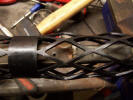
I can't explain how it was made to be honest as inside the 2 halves of
the column there are plastic "sleeves" and the pegs seem to come out of
the sleeves, but I can't see how???
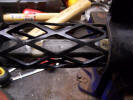 These sleeves were missing on
my old column, which is why it came apart. These sleeves were missing on
my old column, which is why it came apart.
Once the 2 halves were apart, I removed the old bearing.
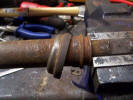 The heat from the exhaust
manifold has cause a lot of corrosion The heat from the exhaust
manifold has cause a lot of corrosion
The bronze bush could then be re-fitted to the column.
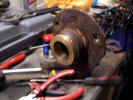
And the shaft in inserted.
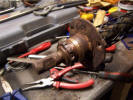
The next job was to take the steering lock off the old column and fit
it to the new one. This can be difficult as there are bolts holding it on
which are designed to sheer off when tightened to a certain torque,
leaving a flush finish so thieves can't remove it.
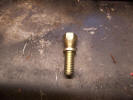
Luckily only one of mine had been broken off
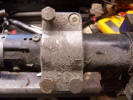
I used a screw driver to turn it gently.
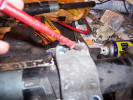
Once it was out I cut a slot in it with a hacksaw.
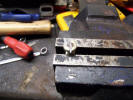
Once the column was back in the car and bolted back into place, the
refitting of the indicators can take place. There is a plastic collar
which operates the indicators which needs lining up. There is a spring
clip which its around the column and fits into a slot on the plastic
collar.
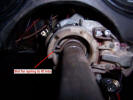 The spring clip needs to
be on the opposite side to the indicator. The spring clip needs to
be on the opposite side to the indicator.
Once this is in place, you can then line the indicator mechanism up
with a peg on the plastic collar.
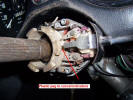
It's just a case now of refitting everything, making sure you get your
wheel in the dead ahead position so you can refit the steering wheel in a
straight line.
What started as a quick job rapidly turned into a major project, but
it's done now and won't need doing for a veeeerrrry long time I hope.
|